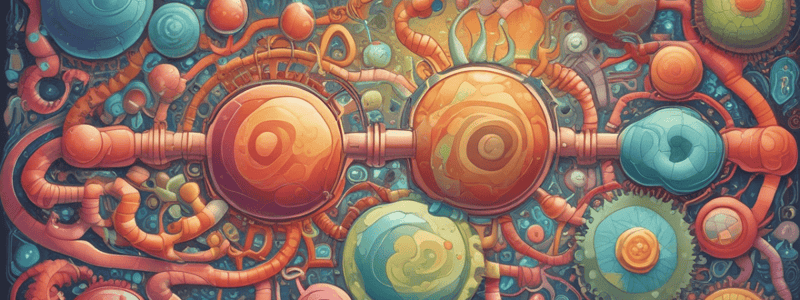Podcast
Questions and Answers
What is the primary source of energy for synthesizing ATP in the body?
What is the primary source of energy for synthesizing ATP in the body?
- Glycogen
- Fructose
- Glucose (correct)
- Galactose
What is the process called when excess glucose is stored in the liver and skeletal muscles?
What is the process called when excess glucose is stored in the liver and skeletal muscles?
- Glycolysis
- Gluconeogenesis
- Glycogenesis (correct)
- Lipogenesis
How is glucose absorbed in the gastrointestinal tract?
How is glucose absorbed in the gastrointestinal tract?
- Osmosis
- Secondary active transport (correct)
- Passive transport
- Facilitated diffusion
What is the primary function of insulin in glucose metabolism?
What is the primary function of insulin in glucose metabolism?
What is the fate of excess glucose when glycogen storage areas are filled?
What is the fate of excess glucose when glycogen storage areas are filled?
What is the primary function of the liver in carbohydrate metabolism?
What is the primary function of the liver in carbohydrate metabolism?
What is the type of transport that occurs when glucose moves from the blood into most other body cells?
What is the type of transport that occurs when glucose moves from the blood into most other body cells?
What is the byproduct of glucose oxidation in cells?
What is the byproduct of glucose oxidation in cells?
What is the role of Na+ in glucose absorption in the GI tract?
What is the role of Na+ in glucose absorption in the GI tract?
What is the fate of glucose when it is used to form amino acids?
What is the fate of glucose when it is used to form amino acids?
What is the primary purpose of glucose phosphorylation?
What is the primary purpose of glucose phosphorylation?
What is the net gain of ATP molecules during glycolysis?
What is the net gain of ATP molecules during glycolysis?
What is the primary source of ATP molecules during aerobic respiration?
What is the primary source of ATP molecules during aerobic respiration?
What is the term for the conversion of glucose to glycogen in the liver and skeletal muscle?
What is the term for the conversion of glucose to glycogen in the liver and skeletal muscle?
What is the fate of pyruvic acid when oxygen is in short supply?
What is the fate of pyruvic acid when oxygen is in short supply?
Which of the following hormones stimulates glycogenolysis?
Which of the following hormones stimulates glycogenolysis?
What is the source of coenzyme A (CoA)?
What is the source of coenzyme A (CoA)?
What is the primary function of the Krebs cycle?
What is the primary function of the Krebs cycle?
What is the primary purpose of gluconeogenesis?
What is the primary purpose of gluconeogenesis?
What is the byproduct of the electron transport chain?
What is the byproduct of the electron transport chain?
Where does the process of glycogenesis occur?
Where does the process of glycogenesis occur?
What is the term for the breakdown of glycogen into glucose?
What is the term for the breakdown of glycogen into glucose?
What is the mechanism of ATP generation in the electron transport chain?
What is the mechanism of ATP generation in the electron transport chain?
What is the total number of ATP molecules generated from one molecule of glucose during aerobic respiration?
What is the total number of ATP molecules generated from one molecule of glucose during aerobic respiration?
Which of the following is NOT a stimulator of gluconeogenesis?
Which of the following is NOT a stimulator of gluconeogenesis?
What is the purpose of carbohydrate loading?
What is the purpose of carbohydrate loading?
Where do the reactions of glycolysis occur?
Where do the reactions of glycolysis occur?
What is the role of the electron transport chain in aerobic respiration?
What is the role of the electron transport chain in aerobic respiration?
How many ATP molecules are generated from substrate-level phosphorylation in glycolysis?
How many ATP molecules are generated from substrate-level phosphorylation in glycolysis?
What is the site of the principal events of the various stages of cellular respiration?
What is the site of the principal events of the various stages of cellular respiration?
Flashcards are hidden until you start studying
Study Notes
Carbohydrate Metabolism
- During digestion, polysaccharides and disaccharides are converted to monosaccharides (primarily glucose) and absorbed through capillaries in villi.
- Glucose is transported to the liver via the hepatic portal vein, where liver cells convert remaining fructose and galactose to glucose.
Fate of Glucose
- Glucose is the body's preferred source for synthesizing ATP, and its fate depends on the energy needs of body cells.
- If cells require immediate energy, glucose is oxidized to produce ATP.
- Glucose can be used to form amino acids, which are incorporated into proteins.
- Excess glucose can be stored as glycogen in the liver and skeletal muscles through glycogenesis.
- If glycogen storage areas are filled, liver cells and fat cells convert glucose to glycerol and fatty acids for synthesis of triglycerides (neutral fats) in lipogenesis.
Glucose Movement into Cells
- Glucose absorption in the GI tract is accomplished by secondary active transport (Na+ - glucose symporters).
- Glucose movement from blood into most body cells occurs via facilitated diffusion transporters (Gly-T molecules).
- Insulin increases the insertion of Gly-T molecules into the plasma membranes, thus increasing the rate of facilitated diffusion of glucose.
- Glucose is trapped in the cell when it becomes phosphorylated.
Glucose Catabolism
- Glucose oxidation, also known as cellular respiration, occurs in every cell of the body (except red blood cells, which lack mitochondria) and provides the cell's chief source of energy.
- The complete oxidation of glucose to CO2 and H2O produces large amounts of energy and occurs in four successive stages: glycolysis, formation of acetyl coenzyme A, the Krebs cycle, and the electron transport chain.
Glycolysis
- Glycolysis is the breakdown of the six-carbon molecule, glucose, into two three-carbon molecules of pyruvic acid.
- The reactions of glycolysis use two ATP molecules, but produce four, a net gain of two.
- The fate of pyruvic acid depends on the availability of O2: it is reduced to lactic acid under anaerobic conditions, and converted to acetyl coenzyme A and enters the Krebs cycle under aerobic conditions.
Formation of Acetyl Coenzyme A
- Pyruvic acid is prepared for entrance into the Krebs cycle by conversion to a two-carbon compound (acetyl group) followed by the addition of coenzyme A (CoA) to form acetyl coenzyme A (acetyl CoA).
- Coenzyme A is derived from pantothenic acid, a B vitamin.
Krebs Cycle
- The Krebs cycle, also called the citric acid cycle or tricarboxylic acid (TCA) cycle, is a series of biochemical reactions that occur in the matrix of mitochondria.
- The large amount of chemical potential energy stored in intermediate substances derived from pyruvic acid is released step by step.
- The Krebs cycle involves decarboxylations and oxidations and reductions of various organic acids, producing 6 NADH, 6 H+, and 2 FADH2, and generating 2 ATP molecules by substrate-level phosphorylation.
Electron Transport Chain
- The electron transport chain involves a sequence of electron carrier molecules on the inner mitochondrial membrane, capable of a series of oxidation-reduction reactions.
- As electrons are passed through the chain, energy is released and transferred to ATP for storage through chemiosmosis.
- The process involves a series of oxidation-reduction reactions in which the energy in NADH + H+ and FADH2 is liberated and transferred to ATP for storage.
Glucose Anabolism
- Glucose can be converted to glycogen for storage in the liver and skeletal muscle through glycogenesis, stimulated by insulin.
- Glucose can be converted back to glycogen through glycogenolysis, stimulated by glucagon and epinephrine.
- Gluconeogenesis is the conversion of protein or fat molecules into glucose, stimulated by cortisol, thyroid hormone, epinephrine, glucagon, and human growth hormone.
Studying That Suits You
Use AI to generate personalized quizzes and flashcards to suit your learning preferences.



